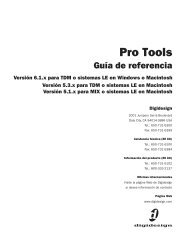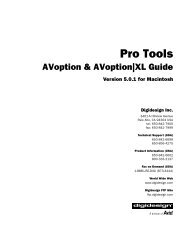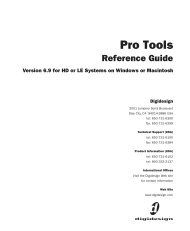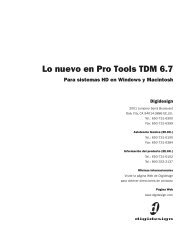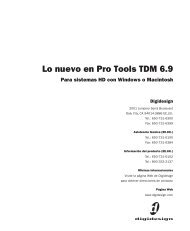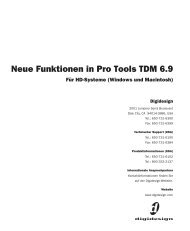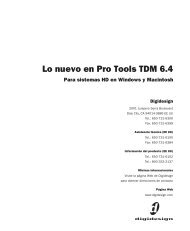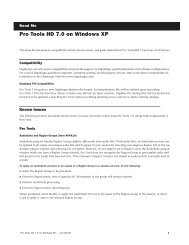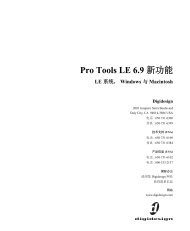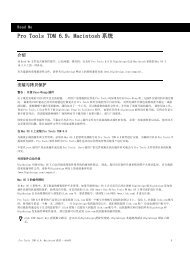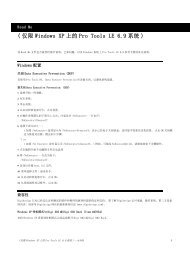5.1 DigiRack Plug-Ins Guide - Digidesign Support Archives
5.1 DigiRack Plug-Ins Guide - Digidesign Support Archives
5.1 DigiRack Plug-Ins Guide - Digidesign Support Archives
Create successful ePaper yourself
Turn your PDF publications into a flip-book with our unique Google optimized e-Paper software.
TC/E Selects the Time Compression & Expansion<br />
plug-in and default settings used when editing<br />
with the Scrub Trimmer.<br />
Using AudioSuite <strong>Plug</strong>-<strong>Ins</strong><br />
AudioSuite plug-ins can be applied to whole regions,<br />
partial regions, or selections that are<br />
made up of whole and partial regions across one<br />
or more tracks.<br />
When audio selected in the Edit window includes<br />
partial regions, the regions will automatically<br />
be split into two or more regions when<br />
they are processed. Processing will occur only<br />
on the selection, leaving other regions unchanged.<br />
Only audio files on locally connected hard<br />
drives can be processed with AudioSuite plugins.<br />
You cannot process audio files on remote<br />
hard drives over a network.<br />
Processing a locked region will cause the region<br />
to become unlocked. For more information<br />
about locked regions, refer to the<br />
Pro Tools Reference <strong>Guide</strong>.<br />
Selecting Tracks for AudioSuite<br />
Processing<br />
Because AudioSuite processes are performed on<br />
the specific regions that you select, it is important<br />
that you select only those regions you actually<br />
want to process.<br />
Selecting a region in the Audio Regions List will<br />
automatically select it in a track (if it currently<br />
resides on one). This is Pro Tools default behavior.<br />
You can change this, however, using the Region<br />
Selection Follows Track Selection, and<br />
Track Selection Follows Regions List Selection<br />
options in the Editing page of the Preferences dialog.<br />
See the Pro Tools Reference <strong>Guide</strong> for an explanation<br />
of these Preferences.<br />
When processing a single audio channel<br />
with an AudioSuite plug-in, make sure that<br />
the plug-in is set to Mono mode (if available).<br />
Selecting Tracks for Delay or Reverb<br />
Processing<br />
Because some AudioSuite effects such as delay<br />
and reverb add additional material to the end of<br />
the selected audio (a reverb tail or a delay tap), it<br />
is very important that you make a selection that<br />
is longer than the original source material so that<br />
the plug-in can write it into the audio file.<br />
If you select only the original material, without<br />
leaving additional space at the end, a reverb decay<br />
or delay that occurs after the end of the region<br />
will be cut off.<br />
To accommodate for this, place the region in a<br />
track, and select the desired audio plus an<br />
amount of blank space at the end of the region<br />
equal to the amount of delay or reverb decay<br />
that you have added in the plug-in. The plug-in<br />
will then have space at the end of the region in<br />
which to write the final delay or decay.<br />
If you select more blank space than you need,<br />
you can remove it using the Trim tool after applying<br />
AudioSuite processing.<br />
Chapter 3: Working with AudioSuite <strong>Plug</strong>-<strong>Ins</strong> 23



